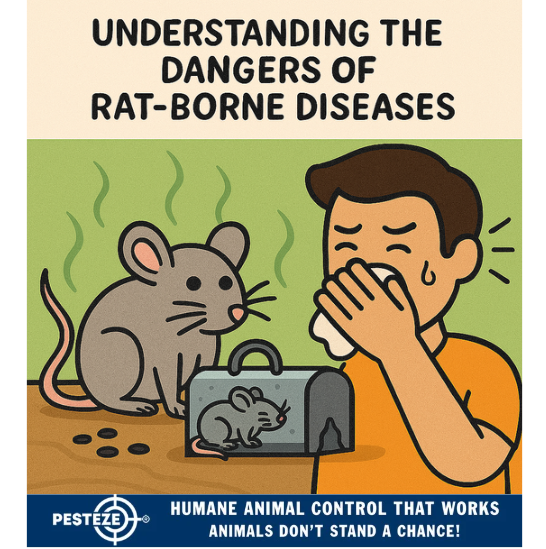UNDERSTANDING THE DANGERS OF RAT-BORNE DISEASES

UNDERSTANDING THE DANGERS OF RAT-BORNE DISEASES
SUMMARY
Rats are more than just unwelcome pests—they’re carriers of serious diseases that can impact human health and safety. From contaminated surfaces to airborne particles, rat-borne illnesses spread quickly and silently. This guide explores the most common diseases transmitted by rats, how they spread, and what you can do to protect your household. Whether you live in an urban area or rural setting, understanding these risks is essential for prevention and early intervention.
FEATURES
-
Common Rat-Borne Diseases: Learn about leptospirosis, hantavirus, salmonella, and more.
-
Transmission Pathways: Discover how diseases spread through droppings, bites, and contaminated surfaces.
-
Symptoms to Watch For: Identify early signs of infection in humans and pets.
-
High-Risk Environments: Understand where rat exposure is most likely to occur.
-
Prevention Strategies: Implement sanitation and rodent-proofing techniques to reduce risk.
-
When to Seek Help: Know when to contact medical professionals or pest control services.
GUIDE DESCRIPTION
Rats are notorious for spreading a range of dangerous diseases that can affect humans and animals alike. These diseases are often transmitted through direct contact with rat droppings, urine, saliva, or bites, and can also spread indirectly via contaminated food, water, or air particles. This guide provides a comprehensive overview of the health risks associated with rat infestations and how to mitigate them.
Among the most concerning rat-borne illnesses are leptospirosis, which can cause kidney and liver damage; hantavirus, a potentially fatal respiratory disease; and salmonella, a bacterial infection that leads to severe gastrointestinal distress. Other risks include rat-bite fever, tularemia, and plague—though rare, these can be life-threatening if untreated.
Transmission often occurs in areas with poor sanitation, clutter, or standing water. Homes with food left out, unsecured garbage, or easy rodent access are particularly vulnerable. Symptoms of rat-borne diseases vary but may include fever, chills, muscle aches, vomiting, and respiratory issues. Pets may also show signs of lethargy, appetite loss, or unusual behavior.
To prevent exposure, maintain a clean living space, seal entry points, and store food in airtight containers. Regularly inspect basements, attics, and crawl spaces for signs of infestation. If you suspect contact with rat-contaminated materials or experience symptoms, seek medical attention immediately.
Professional pest control services can help eliminate infestations safely and thoroughly. Early detection and proactive prevention are key to protecting your health and home from the hidden dangers of rat-borne diseases.
- Amy Chang


Comments 0